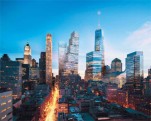Second Life of the Second Tower

Since that day, when as a result of a terrorist attack in New York were destroyed the famous WTC Twin Towers, passed nearly 14 years. And the place where previously housed the World Trade Center buildings is called Ground Zero. What should be constructed in this area? How should it look like? These issues have been discussed almost immediately after the tragedy, and for the conductive solution were spent countless hours and billions of dollars. The plans were changed repeatedly. The World Trade Center has chewed up many other “starchitects,” and many critics say it has yielded a mishmash of sparsely populated office buildings that look banal or worse.
In 2011, where before rose the Twin Towers, it was inaugurated the 9/11 Memorial, the transit hub, and the 9/11 Museum dedicated to the tragedy. Two years later, was completed construction of the World Trade Center One, or Freedom Tower - the central building of the World Trade Center cluster, located on the northwest corner of the site, which previously housed the ruined complex. According to the plans for the development of the territory, alongside was to appear another skyscraper, known as the World Trade Center Two. However, its construction was suspended in the same 2013, after the completion of foundation works. What was the reason? To understand this, you need to unwind the film a little back.
The World Trade Center was located, in the New York area, known as the Financial District - the epicenter of the world’s financial transactions, often referred to as an “icon of the business world,” and associated with the multitude people dressed according to a strict dress code. But over time, there began to appear more and more companies working in advertising, design and high-tech industries, which certainly affected on the atmosphere of this district.
New creative orientation of the neighborhood has sparked interest of media tycoon Rupert Murdoch, whose son James (CEO of 21st Century Fox) just was looking for a place for a new headquarters. Larry Silverstein, the developer who leased the Twin Towers before their destruction and has played a central role in the redevelopment ever since, had a prime piece of land to offer: the last of four skyscraper sites set out in a decade-old master plan. But there was an obstacle to making a deal. There was already a design for the building, officially known as Two World Trade Center, which Silverstein commissioned years ago.
Lord Norman Foster, the 80-yearold architect of acclaimed buildings like London’s iconic Gherkin, had envisioned a gleaming 79-story trophy along the Hudson River, crowned by a slanted glass roof divided into four diamonds. Due to the complexities of the World Trade Center’s redevelopment, a foundation had already been constructed at the time the property’s ultimate owner, the Port Authority of New York and New Jersey, built the transit hub and shopping mall that are positioned beneath the site. But James Murdoch didn’t care for the building. That’s why Foster was bumped aside in favor of Bjarke Ingels, founder of the architectural firm BIG.
Full content of this issue you can read here
The full version of the article can be read in our printed issue, also you can subscribe to the web-version of the magazine
 Materials provided by Bjarke Ingels Group (BIG)
Materials provided by Bjarke Ingels Group (BIG)


